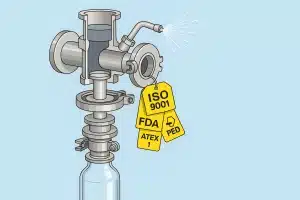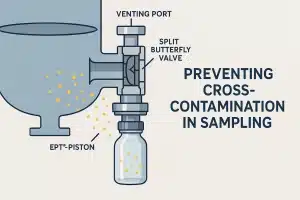Valves play a crucial role in many industrial and domestic systems. Roles of Valves in Industrial and Domestic Systems allow for the control and regulation of the flow, pressure, and direction of fluids (liquids or gases) in various applications. Whether in hydraulic systems, pneumatic systems, heating, air conditioning, or industrial processes, valves are key components that ensure the proper functioning and safety of installations. By doing so, valves help maintain operational efficiency, protect equipment, and ensure the safety of personnel and the environment.
A valve is an essential device that allows for the control, regulation, or stopping of fluid flow, whether liquid or gaseous, in piping networks. Valves can be of different types, such as plug valves, gate valves, globe valves, butterfly valves, etc. They are used in a variety of applications, ranging from domestic systems to industrial installations.
How a Valve Works ?
The operation of a valve depends on its type and specific use. Here are some key points about the general operation of valves:
Flow Control:
Valves allow for the control of the amount of fluid passing through a pipeline. They can be fully or partially opened or closed to adjust the flow.
Pressure Regulation:
Some valves, such as water pressure regulating valves, are designed to maintain a constant pressure in a system by adjusting the valve opening according to fluid pressure variations.
Flow Interruption: Valves can also be used to completely stop the fluid flow, acting like switches to control the passage of liquid or gas.
Valves are crucial elements in fluid management, offering precise control of flow, pressure, and flow interruption in various environments, from domestic applications to complex industrial processes.
Applications of Valves in Various Systems
Valves are used in a multitude of systems, including:
Hydraulic Systems:
Hydraulic valves control the direction, flow, and pressure of fluids in lifting, braking, steering systems, etc. They ensure the safety and precision of these systems.
Pneumatic Systems:
In pneumatic systems, valves control the direction and flow of compressed air. They are used in pneumatic tools, control and regulation systems, etc.
Heating and Air Conditioning Systems:
Thermostatic valves regulate the temperature in radiators and air conditioning systems. They optimize the comfort and energy efficiency of these installations.
Industrial Processes:
In factories, valves control the flow of raw materials, semi-finished products, and finished products. They ensure process regulation and guarantee product quality.
Safety Systems:
Safety valves are designed to protect installations in case of overpressure or failure. They release pressure to prevent potential damage.
Valves are essential components in many systems, contributing to their efficiency, safety, and reliability. Their use is indispensable for ensuring the proper functioning of installations and industrial processes.
Let’s check this article to get more information about Industrial valve manufacturers: Essential for Industrial Process Reliability
The advantages and disadvantages of different types of industrial valves
The advantages and disadvantages of different types of industrial valves are detailed in the provided sources. Here is a summary of relevant information extracted from the sources:
Gate Valve
Advantages:
- Low fluid resistance.
- Small torque required for opening and closing.
- Can be used on a ring network pipeline.
- Less corrosion of the working fluid on the sealing surface compared to the globe valve.
- Relatively simple body structure.
- Relatively short structure length.
Disadvantages:
- Large overall size and opening height.
- Significant space required for installation.
- Limited to low-temperature fluid systems.
Butterfly Valve
Advantages:
- Easy and quick to open and close.
- Low fluid resistance.
- Simple and compact structure.
- Good sealing at low pressure.
- Good regulation performance.
- Low opening and closing torque.
- Rubber and plastic sealing materials provide good sealing at low pressure.
- Easy to install.
- Flexible and labor-saving operation.
Disadvantages:
- Limited pressure and temperature range.
- Poor sealing.
This information provides an overview of the advantages and disadvantages of gate valves and butterfly valves, two commonly used types of industrial valves.
Explore our different products here : sampling valves.





